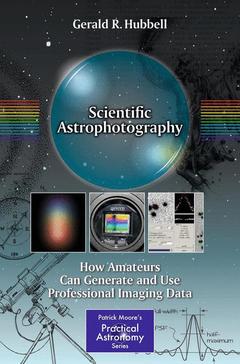Scientific Astrophotography, 2013 How Amateurs Can Generate and Use Professional Imaging Data The Patrick Moore Practical Astronomy Series
Auteur : Hubbell Gerald R.

This book is unique in that it gives readers the skills necessary for obtaining excellent images for scientific purposes in a concise and procedurally oriented manner. This not only gets the reader used to a disciplined approach to imaging to maximize quality, but also to maximize the success (and minimize the frustration!) inherent in the pursuit of astrophotography. The knowledge and skills imparted to the reader of this handbook also provide an excellent basis for ?beautiful picture? astrophotography!
There is a wealth of information in this book ? a distillation of ideas and data presented by a diverse set of sources and based on the most recent techniques, equipment, and data available to the amateur astronomer. There are also numerous practical exercises. Scientific Astrophotography is perfect for any amateur astronomer who wants to go beyond just astrophotography and actually contribute to the science of astronomy.
Foreword.- Acknowledgements.- About the Author.- Table of Contents.- List of Figures.- List of Tables.- Preface.- Chapter 1: Introduction to Scientific Astrophotography.- PART I: Astronomical Imaging System (AIS).- Chapter 2: The "Perfect AIS".- Chapter 3: The Astrograph - The Imaging Telescope.- Chapter 4: CCD Chip Performance, CCD Camera Basics, and Image Scaling Factors.- Chapter 5: Telescope Mount Factors.- Chapter 6: Imaging Filters and Auxiliary Optical/Mechanical/Electrical Components.- Chapter 7: Astrograph and CCD Combinations.- Chapter 8: Environmental and External Factors.- PART II: Astronomical Imaging System (AIS) Integration and Operation.- Chapter 9: The Practical AIS - The Sum is Greater than the Parts.- Chapter 10: Planning and Executing the AIS Data Acquisition Process.- Chapter 11: Image Acquisition and Calibration.- Chapter 12: Field Practical Exercises (FPE) - Putting It All Together.- PART III: Scientific Image Data Analysis and Advanced Amateur Scientific Projects.- Chapter 13: Scientific Image Data Uses and Innovations in AIS Components and Systems.- Chapter 14: An Introduction to Scientific Image Data Analysis.- Chapter 15: Your Scientific Imaging Program and How to Submit Your Data to Scientific Organizations.- Chapter 16: Amateur Astronomer Access to Professional-Level Observatories.- Appendices.- Index.
Jerry Hubbell, currently President of the Rappahannock Astronomy Club (raclub.org), has been an avid amateur astronomer since he was a teenager. However, he developed his passionate interest in astrophotography, and in particular, astrophotography that supports scientific investigation, only about 4 years ago. In that short time, Jerry has become known as a superior astrophotographer, amateur scientist, and mentor to other amateurs who want to foster scientific investigation in the amateur ranks. His career as a nuclear Instrumentation and Controls (I&C) and software engineer for Dominion Virginia Power has trained him well for the attention to detail and precision required for scientific astrophotography. In this book, Jerry refers often to everyday examples from ordinary life, his job, and aviation. He’s also a pilot for the Virginia Defense Force Aviation Battalion, the Commonwealth’s military reserve. His Six Sigma Black Belt training is evident in his careful but accessible step-by-step explanations of how to build your astronomical imaging system, choose your astronomical targets, design a plan to photograph them, avoid the pitfalls, and apply the appropriate methods to obtain scienfitically relevant data suitable for contribution to the larger scientific community. As an active member of the Association of Lunar and Planetary Observers (ALPO), the American Association of the Variable Star Observer’s (AAVSO), and as the owner of a certified observatory location I24 for the IAUs Minor Planet Center, Jerry practices what he preaches in performing his scientific astrophotography. He has had several images published in the ALPOs Lunar Section newsletter, The Lunar Observer, and his work has been acknowledged in Sky and Telescope magazine. Jerry’s minor planet observations have been published in the scientifically peer reviewed Minor Planet Circulars, Minor Planet Circulars Supplement, and ALPOS Minor Planet Bulletin.
Teaches the amateur how to do scientifically useful astronomical imaging at a professional level
Explains how to produce useful data in the fields of astrometry and photometry
Details the steps amateurs must take to begin collaborations with professional astronomers
Includes supplementary material: sn.pub/extras
Date de parution : 11-2012
Ouvrage de 333 p.
15.5x23.5 cm



